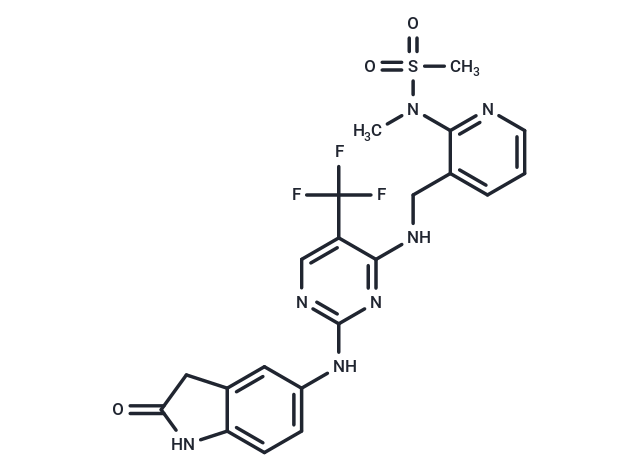Shopping Cart
- Remove All
 Your shopping cart is currently empty
Your shopping cart is currently empty

PF-562271 is an effective ATP-competitive, reversible inhibitor of FAK(IC50=1.5 nM) and Pyk2 kinase(IC50=13 nM).

| Pack Size | Price | Availability | Quantity |
|---|---|---|---|
| 1 mg | $54 | In Stock | |
| 5 mg | $129 | In Stock | |
| 10 mg | $162 | In Stock | |
| 25 mg | $273 | In Stock | |
| 50 mg | $397 | In Stock | |
| 100 mg | $596 | In Stock | |
| 500 mg | $1,250 | In Stock | |
| 1 mL x 10 mM (in DMSO) | $143 | In Stock |
| Description | PF-562271 is an effective ATP-competitive, reversible inhibitor of FAK(IC50=1.5 nM) and Pyk2 kinase(IC50=13 nM). |
| Targets&IC50 | FAK:1.5 nM, PYK2:13 nM |
| In vitro | In rats implanted with MDA-MB-231 cells in the tibia, oral administration of PF-562271 (5 mg/kg) induced an increase in osteocalcin and trabecular bone, thereby slowing the growth of tumor cells. Oral administration of PF-562271 (25 mg/kg) in mouse models with H125 lung xenograft tumors and PC3M-luc-C6 xenografts inhibited tumor cell growth and induced apoptosis. In mice bearing U87 mg tumors, PF-562271 (oral < 33 mg/kg) was able to inhibit tumor FAK phosphorylation in a time- and dose-dependent manner. Oral administration of PF-562271 (50 mg/kg) in BxPc3 and PC3-M xenograft mice effectively inhibited tumor growth. |
| In vivo | PF-562271 binds to the site where ATP and FAK interact, forming inhibitory hydrogen bonds with the main chain atoms in the kinase hinge region. In the chick embryo chorioallantoic membrane, PF-562271 (1 nM) inhibits vascular genesis stimulated by bFGF. In PC3-M cells, PF-562271 (3.3 μM) induces cell cycle arrest at the G1 phase. For A431 cells, PF-562271 (250 nM) inhibits cell invasion into collagen. |
| Kinase Assay | The purified-activated FAK kinase domain (amino acid 410-689) is reacted with 50 μM ATP and 10 μg per well of a random peptide polymer of Glu and Tyr, p(Glu/Tyr), in kinase buffer (50 mM HEPES pH 7.5, 125 mM NaCl, and 48 mM MgCl2) for 15 min. Phosphorylation of p(Glu/Tyr) is challenged with serially diluted compound at 1/2-Log concentrations starting at a top concentration of 1 μM. Each concentration is tested in triplicate. Phosphorylation of p(Glu/Tyr) is detected with a general antiphospho-tyrosine (PY20) antibody followed by horseradish peroxidase (HRP)-conjugated goat anti-mouse IgG antibody. HRP substrate is added, and absorbance readings at 450 nm are obtained after addition of stop solution (2 M H2SO4). IC50 values are determined using the Hill-Slope Model[1]. |
| Cell Research | PF-562271 (Haoyuan Chemexpress Co., Ltd.) is dissolved in DMSO and stored, and then diluted with appropriate media before use[2]. Ewing sarcoma cells are plated in 10-cm dishes, allowed to adhere for 24 hours, and then treated with PF-562271, PD0325901, or Dasatinib. ATP content is measured as a surrogate for cell number using the CellTiter-Glo Luminescent Cell Viability Assay. Luminescence readings are obtained using the FLUOstar Omega microplate reader. For experiments with small-molecule treatment, 1.25×103 Ewing sarcoma cells are seeded in each well and treated with a range of concentrations. IC50 values are calculated from ATP measurements obtained after 3 days of treatment using log-transformed, normalized data in GraphPad Prism 5.0. Cell lines are also treated with compound in 6-cm dishes, trypsinized, and counted by light microscopy using trypan blue exclusion. For experiments using shRNA-transduced cells, 1.25×103 cells are seeded per well into 384-well plates on day 3 posttransduction. ATP content is measured on days 3, 6, and 8 posttransduction[2]. |
| Alias | PF562271, PF 562271 |
| Molecular Weight | 507.49 |
| Formula | C21H20F3N7O3S |
| Cas No. | 717907-75-0 |
| Smiles | CN(c1ncccc1CNc1nc(Nc2ccc3NC(=O)Cc3c2)ncc1C(F)(F)F)S(C)(=O)=O |
| Relative Density. | 1.54 |
| Storage | store at low temperature | Powder: -20°C for 3 years | In solvent: -80°C for 1 year | Shipping with blue ice. | |||||||||||||||||||||||||||||||||||
| Solubility Information | DMSO: 93 mg/mL (183.25 mM), Sonication is recommended. Ethanol: < 1 mg/mL (insoluble or slightly soluble) | |||||||||||||||||||||||||||||||||||
Solution Preparation Table | ||||||||||||||||||||||||||||||||||||
DMSO
| ||||||||||||||||||||||||||||||||||||

Copyright © 2015-2025 TargetMol Chemicals Inc. All Rights Reserved.